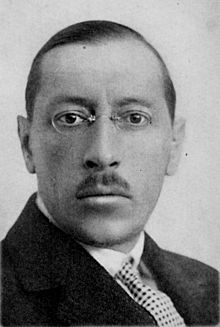Les noces facts for kids
Quick facts for kids Les Noces |
|
|---|---|

Stravinsky in 1920
|
|
| Choreographed by | Bronislava Nijinska |
| Composed by | Igor Stravinsky |
| Libretto by | Igor Stravinsky |
| Based on | Russian wedding lyrics |
| Date of premiere | 13 June 1923 |
| Place of premiere | Théâtre Gaite-Lyrîqué Paris |
| Original ballet company | Diaghilev's Ballets Russes |
| Characters | Nastasia, the bride Fétis, the groom Their families and friends |
| Designs by | Natalia Goncharova |
| Setting | Peasant household in Russia Time immemorial |
| Genre | Modernism |
| Type | Modern |
Les Noces (English: The Wedding) is a ballet in four scenes, originally for the Ballets Russes of Sergei Diaghilev. The ballet was choreographed by Bronislava Nijinska and the music and words were written by Igor Stravinsky. The music is written for voices, four pianos, and percussion.
The ballet was first presented on 13 June 1923 at the Théâtre Gaîte-Lyrîqué in Paris. The ballet is sometimes called a "dance cantata", and the music is sometimes performed as a concert piece.
Background
In 1915 ballet producer Sergei Diaghilev wanted to create a ballet called La Liturgie. Its background would be the Greek Orthodox Church. Stravinsky was a strong Christian, and did not want to write this ballet. He turned instead to Russian folk songs for Les Noces. He had started to think about this in 1913. Michel Fokine started the choreography but Vaslav Nijinsky took over. Leonide Massine stepped in for Nijinsky. When Massine left, Bronislava Nijinska designed the dancing.
Design for the ballet (sets and clothing) was done by Natalia Goncharova. Goncharova, an outstanding artist, made two complete designs before her third was accepted. The first two designs were rejected because they did not suit either the dancing or the musical score. The ballet, though based on a folk tale, was modernist in style: Stravinsky and Nijinska thought it was important for its design to be in sympathy with this.
Revivals
The ballet is still in the repertoires of some major ballet companies, such as the Royal Ballet. It was performed in 1936 by Colonel de Basil's Ballets Russes, one of the successor companies to that of Diaghilev. Its post-WWII revival in London (1966) was personally supervised by Nijinska. Because of this, the ballet is still danced to its original choreography. It was also performed at Stuttgart (1974) and Paris (1976). Jerome Robbins choreographed it in the American Ballet Theatre version of 1965.
See also
 In Spanish: Las bodas para niños
In Spanish: Las bodas para niños

